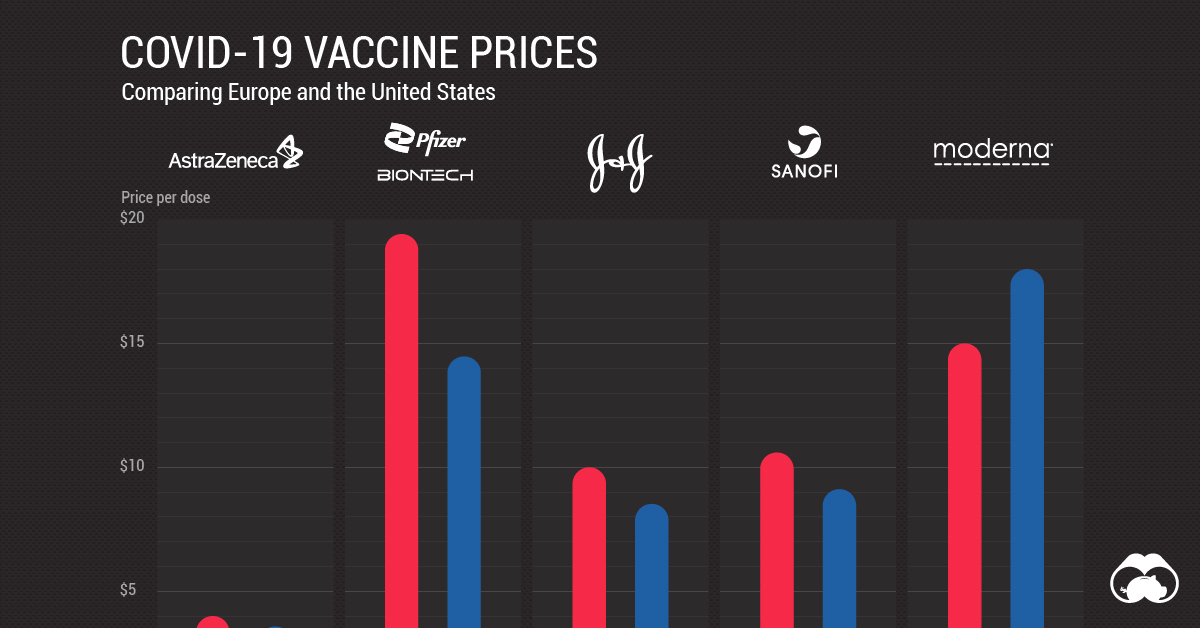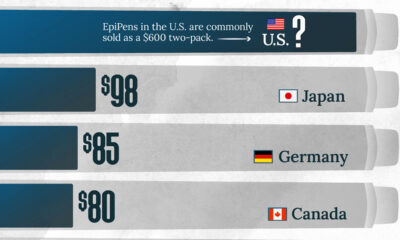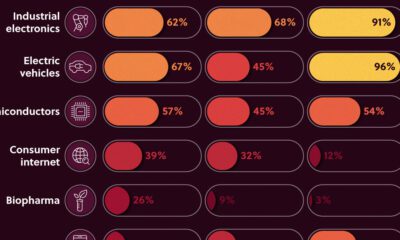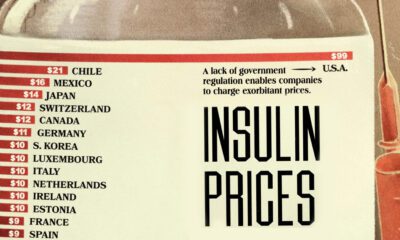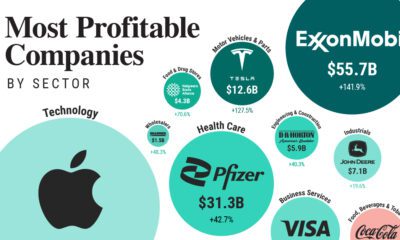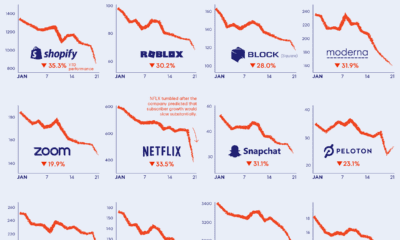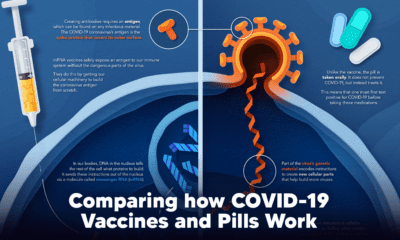Datastream
COVID-19 Vaccine Prices: Comparing the U.S. and EU
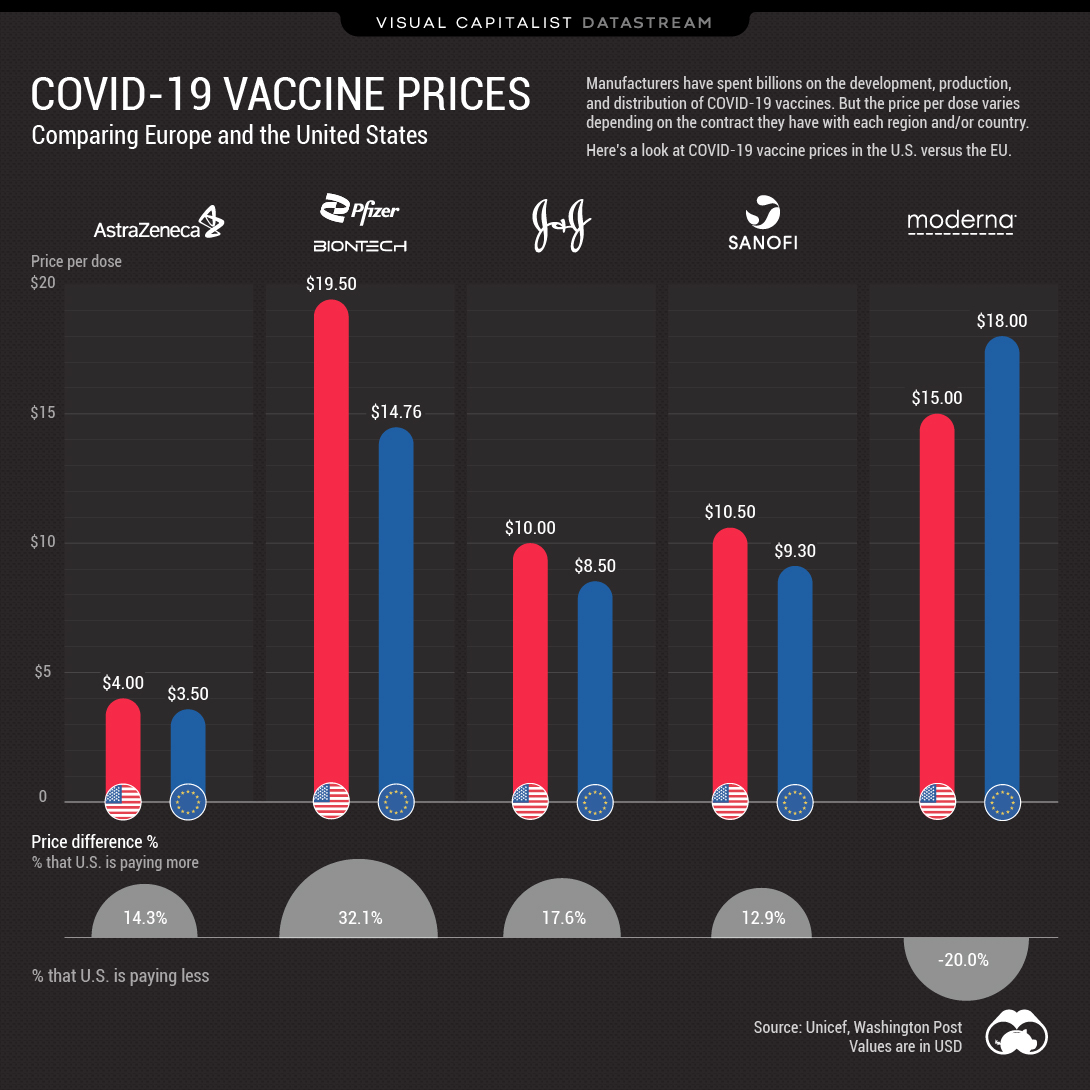
The Briefing
- The U.S. paid 32.1% more per dose for the Pfizer vaccine, compared to the EU
- Between the two areas, the Sanofi vaccine has one of the smallest prices gaps of only 12.9%
Comparing COVID Vaccine Prices between the U.S. and EU
Over two billion COVID-19 vaccine doses have been administered around the world.
But the price governments have paid for the vaccine varies, depending on the region or country. Here’s a look at five major vaccine manufacturers, and their price per dose in the U.S. compared to the EU.
COVID-19 Vaccine Prices: Cost Per Dose
Generally speaking, the EU has paid significantly less than America for a range of COVID-19 vaccines. Pfizer has the biggest price gap, with the U.S. paying 32.1% more per dose.
| Manufacturer | U.S. Price (per dose) | EU Price (per dose) | % Difference U.S. is paying |
|---|---|---|---|
| Pfizer/BioNTech | $19.50 | $14.76 | 32.1% |
| Moderna | $15.00 | $18.00 | -20.0% |
| Sanofi | $10.50 | $9.30 | 12.9% |
| Johnson & Johnson | $10.00 | $8.50 | 17.6% |
| AstraZeneca | $4.00 | $3.50 | 14.3% |
There are a few factors that might explain the price difference. One is early funding—Germany donated millions towards Pfizer’s development.
And while the U.S. did commit to purchasing hundreds of millions of doses of the Pfizer vaccine, the country didn’t provide any funding for the vaccine’s actual development.
Moderna is the only vaccine on the list that is actually cheaper in the U.S., at $15.00 per dose. However, considering that Moderna’s CEO had initially predicted governments would be charged $25-$37 per dose, it looks like both the U.S. and EU managed to negotiate a good deal.
Immunity is the Biggest Cost Saver
At the end of the day, the cost of the vaccine itself is pretty insignificant compared to the economic and emotional toll of an ongoing pandemic.
For instance, a study out of Harvard University estimated the total economic cost of COVID-19 in the U.S. to be in the $16.1 trillion range.
»Want to learn more? Check out our COVID-19 information hub to help put the past year into perspective
Where does this data come from?
Source: Unicef
Notes: Values are in $USD
Datastream
Can You Calculate Your Daily Carbon Footprint?
Discover how the average person’s carbon footprint impacts the environment and learn how carbon credits can offset your carbon footprint.

The Briefing
- A person’s carbon footprint is substantial, with activities such as food consumption creating as much as 4,500 g of CO₂ emissions daily.
- By purchasing carbon credits from Carbon Streaming Corporation, you can offset your own emissions and fund positive climate action.
Your Everyday Carbon Footprint
While many large businesses and countries have committed to net-zero goals, it is essential to acknowledge that your everyday activities also contribute to global emissions.
In this graphic, sponsored by Carbon Streaming Corporation, we will explore how the choices we make and the products we use have a profound impact on our carbon footprint.
Carbon Emissions by Activity
Here are some of the daily activities and products of the average person and their carbon footprint, according to Clever Carbon.
| Household Activities & Products | CO2 Emissions (g) |
|---|---|
| 💡 Standard Light Bulb (100 watts, four hours) | 172 g |
| 📱 Mobile Phone Use (195 minutes per day)* | 189 g |
| 👕 Washing Machine (0.63 kWh) | 275 g |
| 🔥 Electric Oven (1.56 kWh) | 675 g |
| ♨️ Tumble Dryer (2.5 kWh) | 1,000 g |
| 🧻 Toilet Roll (2 ply) | 1,300 g |
| 🚿 Hot Shower (10 mins) | 2,000 g |
| 🚙 Daily Commute (one hour, by car) | 3,360 g |
| 🍽️ Average Daily Food Consumption (three meals of 600 calories) | 4,500 g |
| *Phone use based on yearly use of 69kg per the source, Reboxed | |
Your choice of transportation plays a crucial role in determining your carbon footprint. For instance, a 15 km daily commute to work on public transport generates an average of 1,464 g of CO₂ emissions. Compared to 3,360 g—twice the volume for a journey the same length by car.
By opting for more sustainable modes of transport, such as cycling, walking, or public transportation, you can significantly reduce your carbon footprint.
Addressing Your Carbon Footprint
One way to compensate for your emissions is by purchasing high-quality carbon credits.
Carbon credits are used to help fund projects that avoid, reduce or remove CO₂ emissions. This includes nature-based solutions such as reforestation and improved forest management, or technology-based solutions such as the production of biochar and carbon capture and storage (CCS).
While carbon credits offer a potential solution for individuals to help reduce global emissions, public awareness remains a significant challenge. A BCG-Patch survey revealed that only 34% of U.S. consumers are familiar with carbon credits, and only 3% have purchased them in the past.
About Carbon Streaming
By financing the creation or expansion of carbon projects, Carbon Streaming Corporation secures the rights to future carbon credits generated by these sustainable projects. You can then purchase these carbon credits to help fund climate solutions around the world and compensate for your own emissions.
Ready to get involved?
>> Learn more about purchasing carbon credits at Carbon Streaming
-

 Green2 weeks ago
Green2 weeks agoRanked: Top Countries by Total Forest Loss Since 2001
-

 Travel1 week ago
Travel1 week agoRanked: The World’s Top Flight Routes, by Revenue
-

 Technology2 weeks ago
Technology2 weeks agoRanked: Semiconductor Companies by Industry Revenue Share
-

 Money2 weeks ago
Money2 weeks agoWhich States Have the Highest Minimum Wage in America?
-

 Real Estate2 weeks ago
Real Estate2 weeks agoRanked: The Most Valuable Housing Markets in America
-

 Markets2 weeks ago
Markets2 weeks agoCharted: Big Four Market Share by S&P 500 Audits
-

 AI2 weeks ago
AI2 weeks agoThe Stock Performance of U.S. Chipmakers So Far in 2024
-

 Automotive2 weeks ago
Automotive2 weeks agoAlmost Every EV Stock is Down After Q1 2024




